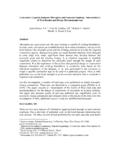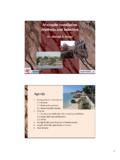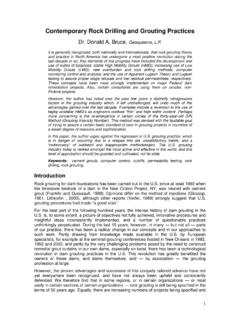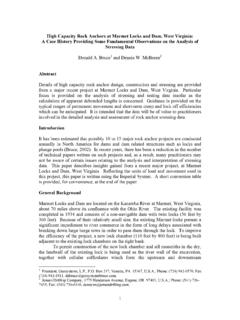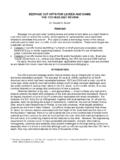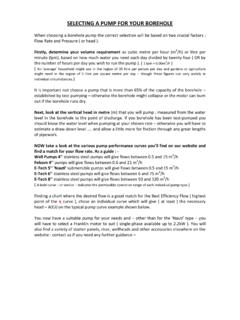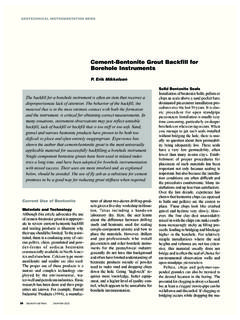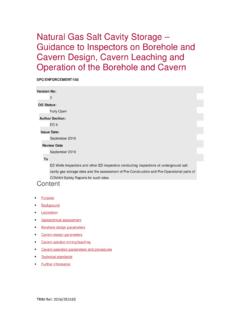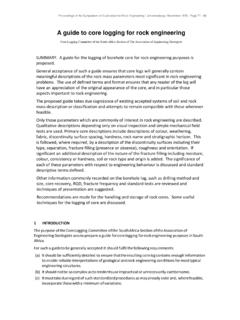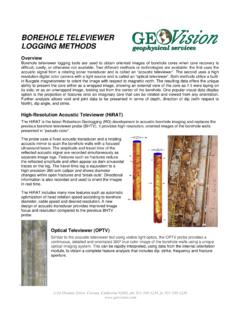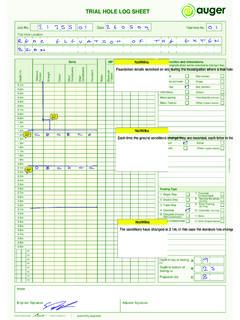Transcription of Practical Aspects of Water Pressure Testing for Rock Grouting
1 1 Practical Aspects of Water Pressure Testing for Rock Grouting Adam Paisley, , Jesse Wullenwaber, , and Donald A. Bruce, , 1 Schnabel Engineering, Inc., 11 Oak Branch Drive, Suite A, Greensboro, NC 27407; Email: 2 Schnabel Engineering, Inc., 1380 Wilmington Pike, Suite 100, West Chester, PA 19380; Email: 3 Geosystems, , Box 237, Venetia, PA 15367; Email: ABSTRACT Rock mass permeability Testing has been performed to characterize rock formations since the early 20th century. It was further popularized by Maurice Lugeon (1933) after he defined a standard unit for quantifying the transmissive ability of rock discontinuities. As the dam and Grouting industries developed and flourished in the latter half of the 20th century, more attention was devoted to better understanding Water Pressure Testing and its application to rock Grouting projects. Today, Water Pressure Testing is a well-established practice and is one of many useful tools for characterizing rock formations.
2 However, it seems the benefits of Water Testing may not be fully understood from a rock Grouting perspective. In several recent Grouting designs, the authors have observed that Water Pressure Testing has been incorporated for the sole purpose of measuring the permeability of the untreated formation. Such a limited use of the test and results inhibits important evaluation of project quality and production efficiency. In the last two decades, the Grouting industry has seemingly dedicated more effort toward technical interpretation of the Water Pressure test while not promoting its many Practical and technical benefits. In this paper, the authors expound on numerous uses for Water Pressure Testing which add to the overall value of a rock Grouting program and advocate for increasing quality and production efficiency. To maintain such progress, geoprofessionals in these industries should maximize the application of available tools and continue promoting innovation in this dynamic field of work.
3 INTRODUCTION The bulk of rock fissure Grouting is conducted for seepage control, as opposed to some form of mechanical improvement of the rock mass. Therefore, it is natural and correct that the main acceptance criterion for a grouted cutoff should be some type of permeability test (to quantify the residual permeability of the treated rock mass). This is commonly known as a Water Pressure 2 test. Such tests also have equal value in characterizing the site before construction begins and to monitor and control the intensity of the work during its implementation. Prior to the work of Maurice Lugeon, as described below, the intensity of Grouting programs was principally dictated by an analysis of grout (not Water takes), or by the available budget. Neither path is acceptable. However, the authors have begun to note a lack of awareness of the true needs for systematic Water Pressure Testing in certain quarters, and seek to reaffirm its essential nature in this paper.
4 WHAT IS Water Pressure Testing ? Water Pressure Testing in rock consists of pressurized injection of Water into boreholes drilled into the rock mass and recording the measured Water flow rate under the applied Pressure (s). The borehole is discretized into intervals, or stages, which are isolated through the use of single or double packers. Water Pressure Testing is typically performed in an upstage manner in a hole that has been drilled to full design depth. In such cases, the bottom stage may be tested using a single packer, and the stages above the bottom stage are tested using a double packer assembly which consists of two packers that are connected by a central perforated pipe. RELATION TO CEMENT Grouting The Grouting industry generally consents that Water Pressure Testing data and Pressure Grouting data are generally not able to be directly correlated. The authors disagree, however, and think that there is much that can be gained from a qualitative comparison of Water Testing and Grouting data.
5 This paper describes multiple uses for Water Pressure Testing results during the course of rock Grouting projects, including comparison with rock Grouting results. The authors consider it imperative to note that the qualitative comparison between Water Pressure Testing and cementitious rock Grouting results relies largely on consistency of grout properties ( density, viscosity, etc.) during the grout injection process. Therefore, cement grouts mentioned in this paper refer to stable grouts, also known as high mobility grouts (HMG), which have a superior resistance to bleed and Pressure filtration. PERMEABILITY AND THE LUGEON VALUE The measured data and observations recorded during Water Pressure tests are used to calculate the permeability of the stage. It is important to qualify and clarify the use of the term permeability . The terms permeability and hydraulic conductivity are more accurately applied to soils which typically contain a relatively regular network of pore spaces which allows fluid to be transmitted uniformly through the soil mass.
6 As noted by Qui ones-Rozo (2010), a rock mass transmits seepage through discrete discontinuities. Therefore, it is more accurate to consider that the data collected during Water Pressure Testing reflect the ability of the discontinuities in a rock mass to transmit Water . While the authors note this distinction as an 3 important concept to be recognized, the term permeability is used herein to refer to the average transmissive ability of rock mass discontinuities. Maurice Lugeon (1933) developed a method for quantifying the permeability of rock based on a Water Pressure test performed in a discrete interval of a borehole. The method produced a permeability unit which became known as the Lugeon. The Lugeon (Lu) is defined as 1 liter per minute (L/min) of Water flow into a Water test stage with a length of 1 meter (m) under an excess Pressure of 10 bars. This may be more clearly understood as follows: Weaver and Bruce (2007) noted that the method was originally devised by Lugeon for measuring Water well inflow and that the applied Pressure of 10 bars (about 145 psi) initially selected to mimic heads created by the Alpine dams of the day is excessive for shallower Grouting projects.
7 Adjustments for applied Pressure (P), fluid flow (Q), and stage length (LS), which may differ from the unit values in Lugeon s method, are accounted for in the following equation for the Modified Lugeon (LuMod): It is important to note that the Lu and LuMod units only apply when injecting Water . When a fluid other than Water is injected, LuMod must be adjusted to account for the difference in apparent viscosity. In rock Grouting practice, the apparent viscosity of stable, non-sanded grouts is commonly represented by the marsh viscosity (vmarsh), which is defined as the amount of time, in seconds, for 1 quart of a fluid to flow from a filled marsh cone. The marsh viscosity of Water is 26 seconds. A LuMod value that is calculated when injecting a stable fluid other than Water is referred to as an Apparent Lugeon (LuApp) value and is calculated as: The LuApp equation is rearranged as such to emphasize that the calculated value is exclusively based on the flow: Pressure ratio when a single fluid is injected into a fixed stage.
8 Since LuMod is intended to represent the in-situ permeability at the depth of the stage, the Pressure value used in the LuMod calculation should represent the actual Pressure applied in the stage. In practice, the term effective Pressure is used to describe the calculated net Pressure 4 applied to the stage and it should be used in the Lugeon equation. Effective Pressure (Peff) is a function of the gauge Pressure (Pgauge) applied by a pump as measured at surface, the net hydrostatic Pressure (Phydro) due to weight of fluid in packer pipe above the stage and the pore Pressure in the formation around the stage, and Pressure loss, or line loss (PLL), in the packer pipe due to friction, and is calculated as follows: Readers are encouraged to consider that the magnitude of the Lugeon value should not be regarded in the same manner on all projects.
9 As shown above, the Lugeon becomes dependent on the relationship between Pressure and flow if the fluid viscosity and stage length are fixed. Using this convention to define maximum effective Pressure for a deeper project as for a shallow project, a relatively high flow ( 10 gallons per minute) will produce a considerably lower Lugeon at deeper depths as compared to the Lugeon produced from the same flow at shallower depths. Therefore, Testing data should be evaluated with respect to project-specific constraints. The length of the Water Pressure test stage can also have a misleading effect on the Lugeon value. The US Bureau of Reclamation (2001) noted that the measured flow during a Water test may be transmitted through the rock mass by only a few discontinuities, and that the resulting calculated Lugeon may not accurately represent the permeability of the formation. Designers may want to specify the option to perform tests with reduced stage length in boreholes where drilling and Testing data suggest the presence of large discontinuities.
10 Water Testing IN PRACTICE Professionals in the rock Grouting industry have endeavored in recent decades to converge in opinion on historically variable Water Pressure Testing conventions. The USACE (2014) presented a comprehensive assembly of commonly accepted practices, but the authors have noted that such practices may not be widely recognized and that reiteration is warranted. Several notable concepts are discussed below. Stepped Tests vs Single- Pressure Tests As explained by Houlsby (1990), the behavior of fractures in a borehole interval can be interpreted from a test where a series of effective pressures are applied to the borehole interval. The LuMod from each Pressure step in the series can collectively suggest the relative number and size of the fractures, the suitability of the maximum design Pressure , and the tendency for infilled particles in the fracture to be dislodged and carried by the pressurized flow.
